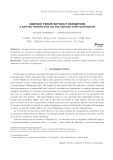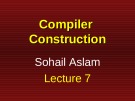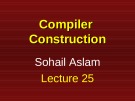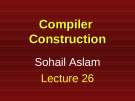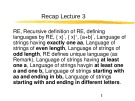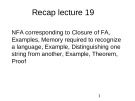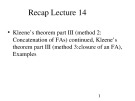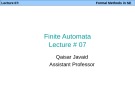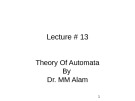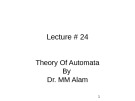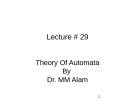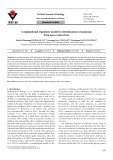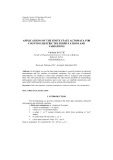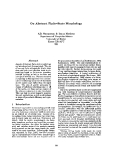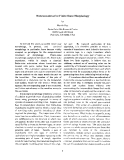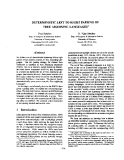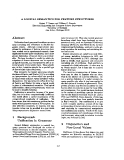
Finite automaton
-
We present here a construction for the derived term automaton (aka partial derivative, or Antimirov, automaton) of a rational (or regular) expression based on a sole induction on the depth of the expression and without making reference to an operation of derivation of the expression.
 21p
21p  vimulcahy
vimulcahy
 18-09-2023
18-09-2023
 6
6
 2
2
 Download
Download
-
Lecture Compiler construction: Lesson 7 - Sohail Aslam. The main topics covered in this chapter include: table encoding of FA, transition table, simulating FA, finite automata, nondeterministic finite automaton (NFA), epsilon moves, deterministic finite automata (DFA), NFAs and DFAs recognize the same set of languages,...
 40p
40p  youzhangjing_1909
youzhangjing_1909
 28-04-2022
28-04-2022
 14
14
 1
1
 Download
Download
-
Lecture Compiler construction: Lesson 25 - Sohail Aslam. The main topics covered in this chapter include: sets of LR(1) items, the closure procedure, the goto procedure, finite automaton of items, nondeterministic finite automaton (NFA), the DFA can be constructed from this NFA using the subset construction, similar to one we used for lexical analysis,...
 25p
25p  youzhangjing_1909
youzhangjing_1909
 28-04-2022
28-04-2022
 16
16
 1
1
 Download
Download
-
Lecture Compiler construction: Lesson 26 - Sohail Aslam. The main topics covered in this chapter include: finite automaton of items, construction of collection of canonical sets of LR(1) items, sets of LR(1) items and augmented grammar, NFA of LR(0) items, LR table construction,...
 35p
35p  youzhangjing_1909
youzhangjing_1909
 28-04-2022
28-04-2022
 8
8
 1
1
 Download
Download
-
Lecture Theory of Automata: Lesson 4. The main topics covered in this chapter include: regular expression of EVEN-EVEN language, difference between a* + b* and (a+b)*, equivalent regular expressions; sum, product and closure of regular expressions; regular languages, finite languages are regular, introduction to finite automaton, definition of FA, transition table, transition diagram;...
 21p
21p  wangziyi_1307
wangziyi_1307
 26-04-2022
26-04-2022
 21
21
 2
2
 Download
Download
-
Lecture Theory of Automata: Lesson 10. The main topics covered in this chapter include: definition of GTG, examples of GTG accepting the languages of strings: containing aa or bb, beginning with and ending in same letters, beginning with and ending in different letters, containing aaa or bbb,...
 18p
18p  wangziyi_1307
wangziyi_1307
 26-04-2022
26-04-2022
 14
14
 2
2
 Download
Download
-
Lecture Theory of Automata: Lesson 20. The main topics covered in this chapter include: recap theorem and example, finite automaton with output, moore machine and examples, Martin’s method, the memory required to recognize,...
 18p
18p  wangziyi_1307
wangziyi_1307
 26-04-2022
26-04-2022
 12
12
 3
3
 Download
Download
-
Lecture Theory of Automata: Lesson 15. The main topics covered in this chapter include: examples of Kleene’s theorem part III (method 3), NFA, examples and avoiding loop using NFA, example and converting FA to NFA, examples and applying an NFA on an example of maze,...
 21p
21p  wangziyi_1307
wangziyi_1307
 26-04-2022
26-04-2022
 13
13
 2
2
 Download
Download
-
Bài giảng Lý thuyết tính toán: Bài 3 - Phạm Xuân Cường cung cấp cho học viên các kiến thức về ôtômat hữu hạn không đơn định; khái niệm; sự tương đương giữa NFA và DFA; định nghĩa hình thức; toán tử chính quy với NFA;... Mời các bạn cùng tham khảo chi tiết nội dung bài giảng!
 30p
30p  bachkhinhdaluu
bachkhinhdaluu
 10-12-2021
10-12-2021
 13
13
 1
1
 Download
Download
-
Lecture Formal methods in software engineering: Finite automata. In this chapter, the following content will be discussed: Yet another method for defining languages, fas and their languages, even-even revisited, how does a finite automaton work? Transition table, FA and their languages.
 38p
38p  larachdumlanat126
larachdumlanat126
 31-12-2020
31-12-2020
 13
13
 1
1
 Download
Download
-
This chapter includes contents: Regular expression of EVEN-EVEN language, Difference between a* + b* and (a+b)*, Equivalent regular expressions; sum, product and closure of regular expressions; regular languages, finite languages are regular, introduction to finite automaton, definition of FA, transition table, transition diagram.
 13p
13p  thuongdanguyetan03
thuongdanguyetan03
 18-04-2020
18-04-2020
 14
14
 1
1
 Download
Download
-
After studying this chapter you will be able to understand: Examples of Kleene’s theorem part III (method 3), NFA, examples, avoiding loop using NFA, example, converting FA to NFA, examples, applying an NFA on an example of maze.
 15p
15p  thuongdanguyetan03
thuongdanguyetan03
 18-04-2020
18-04-2020
 11
11
 2
2
 Download
Download
-
Lecture Theory of automata - Lecture 20 includes the following content: recap theorem, example, finite automaton with output, moore machine, examples.
 23p
23p  thuongdanguyetan03
thuongdanguyetan03
 18-04-2020
18-04-2020
 15
15
 2
2
 Download
Download
-
A nondeterministic finite automaton was designed to monitor enzymatic regulation and detoxification of excess ammonia in the urea cycle and its disorders. The designed machine is used for the diagnosis of deficiency and for regulating the expression of any of the enzymes involved with acceptance and rejection states in the urea cycle.
 5p
5p  vikimsa
vikimsa
 22-02-2019
22-02-2019
 19
19
 0
0
 Download
Download
-
In this paper, we use the finite state automata to count the number of restricted permutations and the number of restricted variations. For each type of restricted permutations, we construct a finite state automaton able to recognize and enumerate them. We, also, discuss how it encompasses the other known methods for enumerating permutations with restricted position, and in one case, we establish connections with some other combinatorial structures, such as subsets and compositions.
 16p
16p  vinguyentuongdanh
vinguyentuongdanh
 19-12-2018
19-12-2018
 12
12
 0
0
 Download
Download
-
Aspects of abstract finite-state morphology are introduced and demonstrated. The use of two-way finite automata for Arabic noun stem and verb root inflection leads to abstractions based on finite-state transition network topology as well as the form and content of network arcs. Nonconcatenative morphology is distinguished from concatenative morphology by its use of movement on the output tape rather than the input tape. The idea of specific automata for classes of inflection inheriting some or all of the nodes, arc form and arc content of the abstract automaton is also introduced. ...
 8p
8p  buncha_1
buncha_1
 08-05-2013
08-05-2013
 42
42
 0
0
 Download
Download
-
In this paper, we present a morphological processor for Modern Greek. From the linguistic point of view, we tr5, to elucidate the complexity of the inflectional system using a lexical model which follows the mecent work by Lieber, 1980, Selkirk 1982, Kiparsky 1982, and others. The implementation is based on the concept of "validation grammars" (Coumtin 1977). The morphological processing is controlled by a finite automaton and it combines a. a dictionary containing the stems for a representative fragment of Modern Greek and all the inflectional affixes with b.
 6p
6p  buncha_1
buncha_1
 08-05-2013
08-05-2013
 37
37
 1
1
 Download
Download
-
In the last few years, so called finite.state morphology, in general, and two-level morphology in particular, have become widely accepted as paradigms for the computational treatment of morphology. Finite-state morphology appeals to the notion of a finite-state transducer, which is simply a classical finite-state automaton whose transitions are labeled with pairs, rather than with single symbols. The automaton operates on a pair of tapes and advances over a given transition if the current symbols on the tapes match the pair on the transition. ...
 9p
9p  buncha_1
buncha_1
 08-05-2013
08-05-2013
 38
38
 2
2
 Download
Download
-
We define a set of deterministic bottom-up left to right parsers which analyze a subset of Tree Adjoining Languages. The LR parsing strategy for Context Free Grammars is extended to Tree Adjoining Grammars (TAGs). We use a machine, called Bottom-up Embedtied Push Down Automaton (BEPDA), that recognizes in a bottom-up fashion the set of Tree Adjoining Languages (and exactly this se0. Each parser consists of a finite state control that drives the moves of a Bottom-up Embedded Pushdown Automaton. ...
 8p
8p  bungio_1
bungio_1
 03-05-2013
03-05-2013
 36
36
 1
1
 Download
Download
-
Unification-based grammar formalisms use structures containing sets of features to describe linguistic objects. Although computational algorithms for unification of feature structures have been worked out in experimental research, these algcwithms become quite complicated, and a more precise description of feature structures is desirable. We have developed a model in which descriptions of feature structures can be regarded as logical formulas, and interpreted by sets of directed graphs which satisfy them.
 10p
10p  bungio_1
bungio_1
 03-05-2013
03-05-2013
 41
41
 3
3
 Download
Download
CHỦ ĐỀ BẠN MUỐN TÌM








